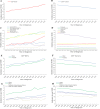Incidence trend and conditional survival estimates of gastroenteropancreatic neuroendocrine tumors: A large population-based study
- PMID: 29873204
- PMCID: PMC6051181
- DOI: 10.1002/cam4.1598
Incidence trend and conditional survival estimates of gastroenteropancreatic neuroendocrine tumors: A large population-based study
Abstract
Given the rarity and indolent clinical course of gastroenteropancreatic neuroendocrine tumors (GEP-NETs), conditional survival might be the most suitable parameter for cancer survivors who wish to receive accurate prognostic information during follow-up. We have explored the updated incidence trend and the conditional survival of patients with GEP-NETs. Incidence trends from 2000 to 2014 were determined through an assessment of patients in the SEER cancer registry. Patients diagnosed between 1988 and 2011 were included in the conditional survival analysis, and the 3-year conditional cancer-specific survival (CCS3) was computed. The incidence of GEP-NETs, which is far higher than the incidence of many malignant tumors, is still increasing steadily (annual percentage change = 4.4). The risk of death from NETs is dynamic over time, and most deaths occur in the first 3 years after diagnosis. Patients with gastric, rectal, or appendiceal NETs hardly exhibit any excess mortality (CCS3 > 95%) given that they have already survived until a defined time-point within 10 years. The initial difference between each age group basically disappeared with an extension of the survival time since the initial diagnosis of gastric, appendiceal, or rectal NETs, but the difference persisted for tumors at other sites. Although patients with advanced-stage or higher-grade tumors have a worse survival at diagnosis than patients with early-stage or lower-grade tumors, the difference diminishes and might even disappear over time. For GEP-NETs that are rare but exhibit slow growth, clinically relevant variations in conditional survival were observed based on the time since diagnosis. Therefore, conditional survival can serve as a guideline that can be used by cancer survivors to plan their future and doctors to plan surveillance schedules.
Keywords: SEER stage; Surveillance; age; conditional survival; gastroenteropancreatic neuroendocrine tumors; incidence trends.
© 2018 The Authors. Cancer Medicine published by John Wiley & Sons Ltd.
Figures





Similar articles
-
Epidemiologic Trends of and Factors Associated With Overall Survival for Patients With Gastroenteropancreatic Neuroendocrine Tumors in the United States.JAMA Netw Open. 2021 Sep 1;4(9):e2124750. doi: 10.1001/jamanetworkopen.2021.24750. JAMA Netw Open. 2021. PMID: 34554237 Free PMC article.
-
Peritoneal Metastases from Gastroenteropancreatic Neuroendocrine Tumors: Incidence, Risk Factors and Prognosis.Ann Surg Oncol. 2017 Aug;24(8):2199-2205. doi: 10.1245/s10434-016-5734-x. Epub 2017 Feb 15. Ann Surg Oncol. 2017. PMID: 28204963
-
Trends in the Incidence, Prevalence, and Survival Outcomes in Patients With Neuroendocrine Tumors in the United States.JAMA Oncol. 2017 Oct 1;3(10):1335-1342. doi: 10.1001/jamaoncol.2017.0589. JAMA Oncol. 2017. PMID: 28448665 Free PMC article.
-
The epidemiology of gastroenteropancreatic neuroendocrine tumors.Endocrinol Metab Clin North Am. 2011 Mar;40(1):1-18, vii. doi: 10.1016/j.ecl.2010.12.005. Endocrinol Metab Clin North Am. 2011. PMID: 21349409 Review.
-
Epidemiology, Incidence, and Prevalence of Neuroendocrine Neoplasms: Are There Global Differences?Curr Oncol Rep. 2021 Mar 14;23(4):43. doi: 10.1007/s11912-021-01029-7. Curr Oncol Rep. 2021. PMID: 33719003 Free PMC article. Review.
Cited by
-
Global research trends in gastroenteropancreatic neuroendocrine tumors: a bibliometric analysis from 2000 to 2023.Front Oncol. 2025 May 22;15:1515893. doi: 10.3389/fonc.2025.1515893. eCollection 2025. Front Oncol. 2025. PMID: 40475014 Free PMC article.
-
Trends of incidence and prognosis of gastric neuroendocrine neoplasms: a study based on SEER and our multicenter research.Gastric Cancer. 2020 Jul;23(4):591-599. doi: 10.1007/s10120-020-01046-8. Epub 2020 Feb 5. Gastric Cancer. 2020. PMID: 32026156 Free PMC article.
-
Epidemiologic Trends of and Factors Associated With Overall Survival for Patients With Gastroenteropancreatic Neuroendocrine Tumors in the United States.JAMA Netw Open. 2021 Sep 1;4(9):e2124750. doi: 10.1001/jamanetworkopen.2021.24750. JAMA Netw Open. 2021. PMID: 34554237 Free PMC article.
-
Epidemiological Data and Treatment of Gastroenteropancreatic Neuroendocrine Neoplasms: Insights From Tertiary Referral Hospitals in Latvia.World J Surg. 2020 Feb;44(2):585-593. doi: 10.1007/s00268-019-05219-0. World J Surg. 2020. PMID: 31605174
-
Random survival forest algorithm for risk stratification and survival prediction in gastric neuroendocrine neoplasms.Sci Rep. 2024 Nov 6;14(1):26969. doi: 10.1038/s41598-024-77988-1. Sci Rep. 2024. PMID: 39506090 Free PMC article.
References
-
- Modlin IM, Oberg K, Chung DC, et al. Gastroenteropancreatic neuroendocrine tumours. Lancet Oncol. 2008;9:61‐72. - PubMed
-
- Modlin IM, Kidd M, Latich I, Zikusoka MN, Shapiro MD. Current status of gastrointestinal carcinoids. Gastroenterology. 2005;128:1717‐1751. - PubMed
-
- Frilling A, Åkerström G, Falconi M, et al. Neuroendocrine tumor disease: an evolving landscape. Endocr Relat Cancer. 2012;19:163‐185. - PubMed
Grants and funding
LinkOut - more resources
Full Text Sources
Other Literature Sources

